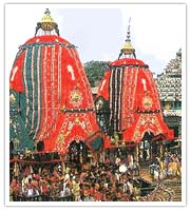The Orissa forests and their management
Adapted from a paper given by Choudhury Gourahari Mishra, Chairman of Shri Jagannath Forest, at Visby’s Faith and Forestry Gathering.
Orissa has rich bio-diversity in her forests, including varieties of wildlife. But the forests– which are largely state-owned - continue to face the rising pressure of an increasing population.
The State has one Biosphere Reserve, two National Parks and 18 Sanctuaries. Most of these forests are covered by Forest Management Plans. There are also many patches of sacred forests known as jahira close to the tribal villages. In addition several sacred shrines are situated inside the forests and many pilgrimage routes pass through the forests. The sacred forests around the villages are maintained by the local people mostly as preservation plots.
The forests of Orissa are unevenly distributed. The coastal areas have 47% of the State’s population but only 16% of the total forest, whereas the central and western parts of the state have 53% of the population but 84% of the forest area.
The key problems facing our forest ecosystem are:
1. Growth in human population
2. Growth in cattle population
3. Forest Fire
4. Grazing
5. Illicit feelings
6. Shifting Cultivation
In addition to the economic exploitation of the forests, the State Government has a statutory obligation to supply timber of 16 defined species to the Shri Jagannath Temple at Puri, one of the principal religious centres of the country. This is for the yearly construction of the three chariots for the annual Chariot Festival, Rath Yatra, which is a State Festival and popular all over the country. This responsibility was formerly the King’s and is an important expression of the traditional link between the State and religion in Hindu society. This obligation suffered a gradual setback in the past 20 years due to fast depletion of forest resources.
 |
 |
 |
Chariot festival in Orissa |
The Shri Jagannath Vana Prakalpa Forest Project was conceived to take advantage of the socio-cultural as well as religious commitment of the people. It builds on a deep link between the forests, the forest dwellers, Shri Jagannath and the spiritual significance of the Chariot Festival. From the ecological point of view, the significance is that it deepens people’s commitment to protect their forests and provides a positive example of the value of Hindu traditions in forest conservation. It is also a model for extending the process of community participation in forest management elsewhere.
This government-run Forest Project started in 1998 and is due to end in 2012. It has had very good participation from the local communities and all levels of Government. So far 2369 hectares have been earmarked for plantation.
In addition another forest project dedicated to the service of Lord Jagannath has been undertaken through the initiative of the Internatinal Society for Krishna Consciousness. Under this project, known as “Shri Jagannath Aranya Prakalpa”, the specific species of trees required for the Lord’s Chariot were planted in 1997 in over 62 hectares in the Nayagarh district. This great plantation was subsequently handed over to the State Government for protection. These newly created and ear-marked Sacred Forests will be managed sustainably under the “selection-cum-improvement” silvicultural system which is appropriate for the species planted as well as for the purpose for which these plantations are dedicated.
Our ancient sages realized the oneness of all existence, that God is immanent in Nature and dwells in all. The Chariot Festival is an occasion when the scriptures encourage the devotees to behold God’s dwelling presence in all this, whatsoever in this universe moves or moves not (Isavasyamidam sarvam yat kincha jagatyam jagat). He says:
“I come to you in all directions through My own creation. I put before you My creation so that you may never forget Me, that I may never be far from you, I may never be something strange”.
|

